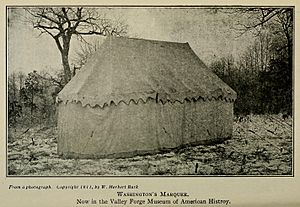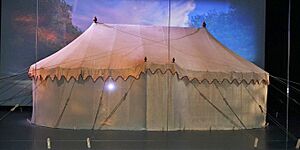George Washington's tent facts for kids

General George Washington used two special tents, called marquees, during much of the American Revolutionary War. When the weather was warm, he used one tent for eating meals with his officers and assistants. The other tent was his military office and where he slept. Pieces of both tents, like the canvas and poles, are still around today. Four different historical groups now own these important parts of history.
Contents
Revolutionary War Tents
Washington's main helpers, including his military secretary and several aides, worked in the office tent. This is where they managed all of Washington's letters and made copies of his orders. A special part of this tent was where Washington slept. His enslaved valet, William Lee, also slept there. The other tent was used for meals.
The first pair of tents were made in Philadelphia in 1776. They were used at the first Middlebrook encampment in 1777. This was a place where the army stayed in Middlebrook, New Jersey. One soldier wrote about it:
The Army is now drawn together at this place... The whole of them now Encamped in Comfortable Tents... His excellency our good Old General, has also spread his Tent, and lives amongst us.
These first tents were used until the winter of 1777–78. That winter, the army stayed at Valley Forge. New tents were ordered in 1778.
Historians describe the tents:
There were two marquées attached to the headquarters during all the campaigns. The larger, or banqueting tent, would contain from forty to fifty persons; the smaller, or sleeping tent, had an inner-chamber, where... Washington was in the habit of seeking privacy... and where he wrote the most memorable of his despatches in the Revolutionary war.
In 2017, experts at the Museum of the American Revolution in Philadelphia studied a painting. They figured out that the painting, by Pierre Charles L'Enfant, showed Washington's office/sleeping tent. It was being used in the field in 1782 at Verplanck's Point.
Tents During the Civil War
The tent pieces and poles were passed down through Washington's family. They went to his grandson, George Washington Parke Custis. He then gave them to his daughter, Mary Anna Custis Lee, and her husband, Robert E. Lee.
During the American Civil War, Union Army soldiers searched Arlington House. But the Lees' enslaved housekeeper, Selina Norris Gray, kept the tent fabric safe. In January 1862, the tents and other Washington items were taken by the government. The land around Arlington House became Arlington National Cemetery.
Later History of the Tents
The tents were shown at the U.S. Patent Office. In 1881, they were moved to the Smithsonian Institution. It took almost 40 years, until 1901, for the tents to be given back to the Lees' son, George Washington Custis Lee.
In 1906, Robert E. Lee's daughter, Mary Anna Custis Lee, gave George Washington's military tents for a special sale. The money raised helped the Home for Needy Confederate Women in Richmond.
In 1909, Reverend Dr. W. Herbert Burk bought the outside part of the office/sleeping tent. He bought it for the Valley Forge Museum of American History. This museum was a first version of the Valley Forge Historical Society. The tent was shown in a museum on the grounds of the 1777–1778 Valley Forge encampment.
Where the Tents Are Now
Today, pieces of Washington's tents are owned by four different historical groups:
- Colonial National Historical Park has the inside roof of the dining tent. They also have the inside of the office/sleeping tent and its poles. You can see these at the Yorktown Battlefield Visitor Center.
- The Mount Vernon Ladies' Association owns the linen door to the office/sleeping tent.
- The Museum of the American Revolution has the outside of the office/sleeping tent. They also have the poles of the dining tent and a storage trunk. This tent is sometimes called the first "Oval Office". It is shown at the Museum of the American Revolution, which opened in 2017.


